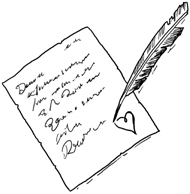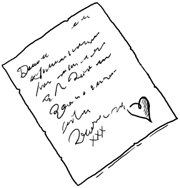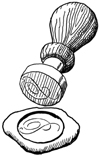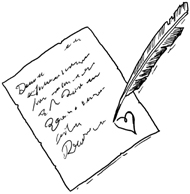
… the first glance to see how many pages there are, the second to see how it ends, the breathless first reading, the slow lingering over each phrase and each word, the taking possession, the absorbing of them, one by one, and finally the choosing of the one that will be carried in one’s thoughts all day, making an exquisite accompaniment to the dull prose of life.
Edith Wharton, on receiving a love letter

Whether long or short the love letter allows the writer the opportunity to express feelings in solitude and to give shape to his or her emotions.
Historically, love letters may have been written in a poetic form – a sonnet, for example. Today, they may be constructed over email. Yet, by their very nature, love letters are personal and ring most true when delivered by post or in person, rather than electronically.
As well as representing tokens of devotion, love letters also hold a symbolic value, bound up in the strength of the relationship between writer and recipient. When love is lost, letters are often burned to represent the breaking of a bond.
Billet-doux
A now archaic term for a love letter, from the French billet, meaning ‘short note’ and doux, meaning ‘sweet’.
Until the twentieth century, love letters were essential in progressing romantic relationships. Passionate sentiments were captured on paper and delivered to the recipient as a physical and lasting declaration. Imagine the excitement of receiving a letter from an absent love when the post was your only means of communicating. Once, a love letter would have sent a heart fluttering.
Fewer and fewer people take the trouble to write by hand nowadays, and the bond between sender and recipient has been replaced by the looseness of instant communication. But the immutability of the physical letter cannot be eroded – anyone who has ever received a love letter will treasure it. If you want to make an enduring declaration, the letter has no rival.
Every love letter is different because it’s personal to both the sender and recipient. But while love may have no bounds, there are some straightforward tips to follow if you want to get the most out of your writing.
![]() Date your letter. Remember that it will be a keepsake and may be re-read in years to come.
Date your letter. Remember that it will be a keepsake and may be re-read in years to come.
![]() Open with a sincere and heartfelt salutation. Don’t shy away from using pet names if they mean something, or flattery if it sets the right tone.
Open with a sincere and heartfelt salutation. Don’t shy away from using pet names if they mean something, or flattery if it sets the right tone.
![]() Explain how you feel about your loved one. You might like to imagine the time when you were last together and the emotions you felt. Try to describe these honestly and confidently. Love cannot be too bold.
Explain how you feel about your loved one. You might like to imagine the time when you were last together and the emotions you felt. Try to describe these honestly and confidently. Love cannot be too bold.
![]() Convey what you love about the recipient – was it a specific character trait, a look or an action? Write why they are special and what it means to be with them.
Convey what you love about the recipient – was it a specific character trait, a look or an action? Write why they are special and what it means to be with them.
![]() Take time to get it right. Draft your letter several times over and ensure that your final version is carefully presented just how you wish it to be.
Take time to get it right. Draft your letter several times over and ensure that your final version is carefully presented just how you wish it to be.
![]() End by considering the past, the present and the future. How has this person changed your life and how do they continue to do so?
End by considering the past, the present and the future. How has this person changed your life and how do they continue to do so?
![]() Close with a meaningful phrase or a heartfelt goodbye. Just writing ‘From David’ would be going out with a whimper, when you really want the recipient’s heart to pound. Words such as ‘All my love, always’ may not be unique but they are simple and expressive.
Close with a meaningful phrase or a heartfelt goodbye. Just writing ‘From David’ would be going out with a whimper, when you really want the recipient’s heart to pound. Words such as ‘All my love, always’ may not be unique but they are simple and expressive.
The oldest Valentine
Uncovered by the British Library, the oldest-known Valentine’s Day message is thought to date back to 1477 and was written in Norfolk. The message is from Margery Brews to her fiancé John Paston and concerns their forthcoming nuptials. It begins: ‘Right reverent and worshipful and my right well-beloved valentine, I recommend me unto you full heartedly, desiring to hear of your welfare, which I beseech Almighty God long for to preserve unto his pleasure and your hearts desire.’ Margery goes on to explain that she has asked her mother to beseech her father to increase her dowry, but maintains that if John loves her he ought to marry her regardless of money: ‘But if you love me, as I trust verily that you do, you will not leave me therefore.’
A love letter rarely requires formality and you may turn to the most fanciful of salutations with which to open your missive. Using your love’s first name or other term of endearment sets the tone for the personal declarations to follow.
Here are some example openings of real-life love letters:
![]() ‘Unspeakably belovedest’
‘Unspeakably belovedest’
(Nathaniel Hawthorne to Sophia Peabody)
![]() ‘My Own Dearest Wifie’
‘My Own Dearest Wifie’
(Charles Stewart Parnell to Kitty O’Shea)
![]() ‘My angel, my all, my very self’
‘My angel, my all, my very self’
(Beethoven to unknown)
![]() ‘Alpha and Omega’
‘Alpha and Omega’
(Horatio Nelson to Emma Hamilton)
![]() ‘Chère amie, chères delices’
‘Chère amie, chères delices’
(Marcel Proust to Laure Hayman)
![]() ‘To ye most loving wife alive’
‘To ye most loving wife alive’
(Chidiock Tichborne to Agnes Tichborne)
![]() ‘My Very Precious One’
‘My Very Precious One’
(Czarina Alexandra to Czar Nicholas II)
![]() ‘My ever-new Delight’
‘My ever-new Delight’
(John Hervey, First Earl of Bristol, to Elizabeth Hervey)
![]() ‘Wonderful Boy’
‘Wonderful Boy’
(Sarah Bernhardt to Victorien Sardou)

We can learn a great deal about past events from the correspondence of the time. But preserved love letters often reveal to us the human hearts behind historical figures.
Peter Abelard (1079–1142) was a French philosopher. Héloise (1101–64) was the niece of Canon Fulbert. They are one of the most celebrated couples; renowned for their passionate love affair, their correspondence, and the tragedy that parted them. Unable to live openly as man and wife, they went into separate religious establishments and it was from here that they wrote their famous correspondence in Latin, mainly concerning lost love.
From Abelard to Héloise:
Write no more to me, Héloise, write no more to me; ’tis time to end communications which make our penances of nought avail. We retired from the world to purify ourselves, and, by a conduct directly contrary to Christian morality, we became odious to Jesus Christ. Let us no more deceive ourselves with remembrance of our past pleasures; we but make our lives troubled and spoil the sweets of solitude. Let us make good use of our austerities and no longer preserve the memories of our crimes amongst the severities of penance. Let a mortification of body and mind, a strict fasting, continual solitude, profound and holy meditations, and a sincere love of God succeed our former irregularities.
From Héloise to Abelard:
I read the letter I received from you with great impatience: in spite of all my misfortunes I hoped to find nothing in it besides arguments of comfort. But how ingenious are lovers in tormenting themselves. Judge of the exquisite sensibility and force of my love by that which causes the grief of my soul. I was disturbed at the superscription of your letter; why did you place the name of Héloise before that of Abelard? What means this cruel and unjust distinction? It was your name only – the name of a father and a husband – which my eager eyes sought for. I did not look for my own, which I would if possible forget, for it is the cause of all your misfortunes. The rules of decorum, and your position as master and director over me, opposed that ceremony in addressing me; and love commanded you to banish it: alas! You know all this but too well!
Early English aristocratic matches were usually made for political reasons and devoid of love, so this letter from Lady Pelham to Sir John Pelham, written in 1399, is unusual in its fondness. It is one of the earliest love letters extant in the English language.
My dear Lord,
I recommend me to your high lordship, with heart and body and all my poor might. And with all this I thank you as my dear Lord, dearest and best beloved of all earthly lords. I say for me, and thank you, dear Lord, with all this that I said before for your comfortable letter that you sent me from Pontefract, that came to me on Mary Magdalene’s day; for by my troth I was never so glad as when I heard by your letter ye were strong enough with the Grace of God to keep you from the malice of your enemies […]

Perhaps most renowned for his six marriages, Henry VIII’s rule was also characterized by the separation of the Church of England from Rome. Henry sought an annulment from his first marriage to Catherine of Aragon in order to marry his sweetheart and infatuation, Anne Boleyn.
A series of undated love letters written to Anne were found in the Vatican Library. Her replies have been lost. The following is one of Henry’s letters.
Myne awne Sweetheart, this shall be to advertise you of the great ellingness [loneliness] that I find her since your departing, for I ensure you, me thinketh the Tyme longer since your departing now last than I was wont to do a whole Fortnight; I think your Kindness and my Fervence of Love causeth it, for otherwise I wolde not thought it possible, that for so little a while it should have grieved me, but now that I am comeing toward you, me thinketh my Pains by half released, and also I am right well comforted, insomuch that my Book maketh substantially for my Matter, in writing whereof I have spent above IIII Hours this Day, which caused me now write the shorter Letter to you at this Tyme, because of some Payne in my Head, wishing my self (specially an Evening) in my Sweethearts Armes, whole pretty Duckys [breasts] I trust shortly to kysse. Writne with the Hand of him that was, is, and shall be yours by his will, H.R.
Napoleon is well known for his passionate love for his wife Josephine although he also wrote to other lovers, including Marie Waleska and Marie-Louise of Austria. His most breathless moments in correspondence, however, he reserved for Josephine, as the following extracts testify:
![]() I awake all filled with you. Your image and the intoxicating pleasures of last night, allow my senses no rest. Sweet and matchless Josephine, how strangely you work upon my heart … My soul is broken with grief and my love for you forbids repose … In three hours I shall see you again. Till then, a thousand kisses, mio dolce amor! But give me none back for they set my blood on fire.
I awake all filled with you. Your image and the intoxicating pleasures of last night, allow my senses no rest. Sweet and matchless Josephine, how strangely you work upon my heart … My soul is broken with grief and my love for you forbids repose … In three hours I shall see you again. Till then, a thousand kisses, mio dolce amor! But give me none back for they set my blood on fire.
![]() Come soon; I warn you, if you delay, you will find me ill. Fatigue and your absence are too much … Your letters are the joy of my days, and my days of happiness are not many … A kiss on the heart, and one lower down, much lower!
Come soon; I warn you, if you delay, you will find me ill. Fatigue and your absence are too much … Your letters are the joy of my days, and my days of happiness are not many … A kiss on the heart, and one lower down, much lower!
![]() Oh, my adorable wife! I don’t know what fate has in store for me, but if it keeps me apart from you any longer, it will be unbearable! My courage is not enough for that …
Oh, my adorable wife! I don’t know what fate has in store for me, but if it keeps me apart from you any longer, it will be unbearable! My courage is not enough for that …
![]() Things are going well here; but my heart is indescribably heavy. You are ill and far away from me. Be gay and take great care of yourself, you are worth more than all the universe to me.
Things are going well here; but my heart is indescribably heavy. You are ill and far away from me. Be gay and take great care of yourself, you are worth more than all the universe to me.

An Italian manuscript, written in Latin on parchment, dating from the twelfth century gives advice on how to write love letters. The author of Modi dictaminum was a cleric called Guido, believed to come from Casentino on the border between Tuscany and Emilia. Its advice includes the following:
![]() Always praise the beauty and qualities of the recipient. Use comparisons to famous couples (Paris and Helen, Pyramus and Thisbe etc) or similarities to precious stones.
Always praise the beauty and qualities of the recipient. Use comparisons to famous couples (Paris and Helen, Pyramus and Thisbe etc) or similarities to precious stones.
![]() Use phrases that indicate how impossible it is to describe the depth of your feeling: ‘How deeply I love you I cannot express with words, even if all the members of my body could talk.’
Use phrases that indicate how impossible it is to describe the depth of your feeling: ‘How deeply I love you I cannot express with words, even if all the members of my body could talk.’
![]() Use apostrophic expressions: ‘your beauty knows’, ‘your sweetness knows’; ‘it is known to your nobility’.
Use apostrophic expressions: ‘your beauty knows’, ‘your sweetness knows’; ‘it is known to your nobility’.
![]() Lament the distance between you with extreme lovesickness: ‘The soul cannot stand much joy’.
Lament the distance between you with extreme lovesickness: ‘The soul cannot stand much joy’.
![]() Refer to the physical side of love: talk of hugs, kisses, desire, of ‘sweet things to do together’.
Refer to the physical side of love: talk of hugs, kisses, desire, of ‘sweet things to do together’.
Britain’s famous wartime Prime Minister Winston Churchill first met Clementine Hozier at a ball in London. He was thirty and an adventurer – a soldier, journalist and politician. She was just nineteen. They met again four years later in 1908 and were irresistibly drawn to one another. They married and then began a lifetime of lively and loving correspondence. In their letters, Clementine referred to herself as ‘Kat’ or ‘Cat’; Winston was ‘Pug’ or ‘Pig’ and their children also received pet names. Their letters were often decorated with drawings and the subject matter ranged widely – not just concerning home and children, but also major political events.
In the spring of 1895 London hung on the three trials involving Oscar Wilde. Wilde had met and fallen in love with the young poet Lord Alfred Douglas (‘Bosie’) in 1891. Wilde had been blackmailed when a man called Alfred Wood found letters written by Wilde to Lord Alfred. But it was Douglas’s father, John Sholto Douglas, who was instrumental in Wilde starting libel proceedings. Correspondence played a large role in the evidence introduced in court. Often highly suggestive, Wilde was questioned regarding the homoerotic connotations of his letters.
Although this letter supports the case against Wilde, his lawyer introduced it to prevent the other side from using it in a more dramatic fashion later.
January 1893, Babbacombe Cliff
My Own Boy,
Your sonnet is quite lovely, and it is a marvel that those red-roseleaf lips of yours should be made no less for the madness of music and song than for the madness of kissing. Your slim gilt soul walks between passion and poetry. I know Hyacinthus, whom Apollo loved so madly, was you in Greek days. Why are you alone in London, and when do you go to Salisbury? Do go there to cool your hands in the grey twilight of Gothic things, and come here whenever you like. It is a lovely place and lacks only you; but go to Salisbury first.
Always, with undying love,
Yours, Oscar
Mystery letter
The following 200-year-old love letter was found in the arm of a chair at the premises of a furniture upholsterer in Gloucestershire, England. The note was tightly folded up to the size of a penny. Written in Old French, in pencil, it was composed from a man to a woman and sent from the town of Mercurol in the Alps. Nothing else is known about it or its lovers.
My dear small love, do not be worried, do you seriously believe I would tell anything to these people, who don’t understand anything about love?
If someone insists that I say something, it will be anything but the dear love acquired by you, which is the great treasure hidden in my heart.
I didn’t tell you to come yesterday because I didn’t have the opportunity, but do come every Tuesday around 5.30, and Fridays as well; I count/hope on you tomorrow.
At the moment I write this letter, I can hear my aunt yelling, who else annoys us all day long, today and tomorrow.
In the early 2000s, Asia Wong from New Orleans decided to turn the idea of the love letter as something personal and singular on its head. She embarked on a project to write 300 letters and send them to strangers. There is something vaguely prurient about reading mail that is not intended for you, and Wong pushed the boundaries further by fixing each love note to the outside of the envelope so it could be read by anyone.
‘Of course, it’s about love, and relationships,’ she says on her website www.sleeptrip.com. ‘By the end of the project I wanted to be able to write a love letter to anyone, a stranger on the street, or someone that I have nothing but scorn for […] I wanted to train my heart to really feel.’
The letters were colour-coordinated – for lovers, strangers, acquaintances, friends, etc. By the end, Wong had actually written a further 100 letters, feeling she hadn’t quite accomplished her emotional journey when she fulfilled her original objective. Here are excerpt from two of her letters.
Letter to a crush
My coffee’s getting cold as I wait for you to show up. Will you, won’t you, will you, won’t you, won’t you, won’t you join the dance? I don’t know you much, but I want to, I want to see you, feel your smile. I’m so close to leaping across, inappropriately, making a fool of myself, falling in love. I want to. Asia

Letter to a dream lover
I’D LIKE TO SINK INTO YOU. And go to sleep for a GOOD, LONG While …
Love, ASIA
The Love Letter Collection is an online and ongoing collection of anonymous love letters, which are submitted by the public. The project was started in 2001 by poet and artist Cynthia Gray and is made up of love letters that have been sent or received, as well as those the writer would like to send but can’t. Letters are selected three times a year and published online at www.collectiveexperience.org. According to the website, ‘the love can be a fantasy love, desperate love, unrequited love, impossible love, I love, frustrated love, absurd love, obsessed love, new love, fleeting love or love lost.’ Here are some moving examples from the collection.
I felt and I honestly wanted:
I’ve never met anyone like you. There was a spark and I thought your eyes were beautiful. I got home and wrote down how I felt and I honestly wanted to die for making a mistake that affected you.
You are special. You had a huge effect on me. I was crying inside because it was impossible.
By the Lake:
My Dear _____
I want you to know that you gave me life again … with those few brief meetings by the lake. I knew then that I could love again. I thought it would be, and I am so sorry it wasn’t. I was planning our wedding day … once again! I was thinking November would have been appropriate. I’ll never regret that you looked me up after all those years.
You have no idea how you broke my heart when you told me you married her. But I owe you a huge Thanks … for letting me know my heart wasn’t dead. I hope your life is good and full of love and happiness. I have moved on. I actually think I’m in love again!
Thanks ______, you gave me my life back … even if you aren’t in it.
P.S. I still love you and always will.
On the Swings:
Today, when you sat next to me on the swings, did you ignore the tears in my eyes as you have ignored my being in love with you for so long?
PS, I Love You
Irish writer Cecelia Ahern’s novel P.S. I Love You became a bestseller in 2004. In the book, a young woman, Holly Kennedy, is grieving after the death of Gerry, the love of her life. However, in the months before his death, Gerry wrote a series of ten letters to Holly, to guide her through her grief and into a new life without him. Each letter signs off in the same way: ‘P.S. I Love You x’.
The novel was made into a movie, released in 2007, starring Hilary Swank and Gerard Butler.